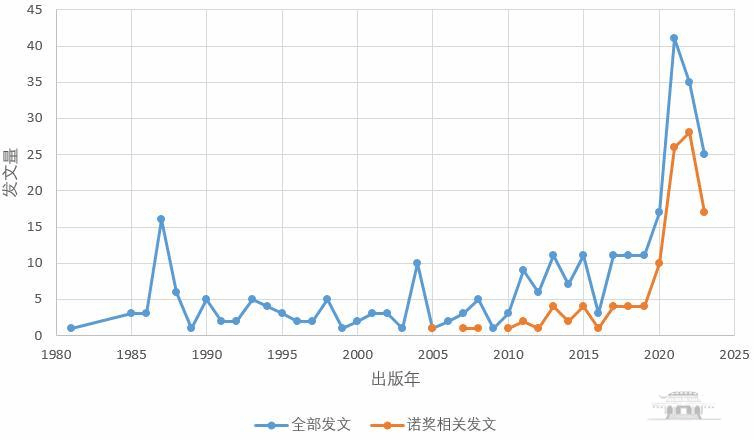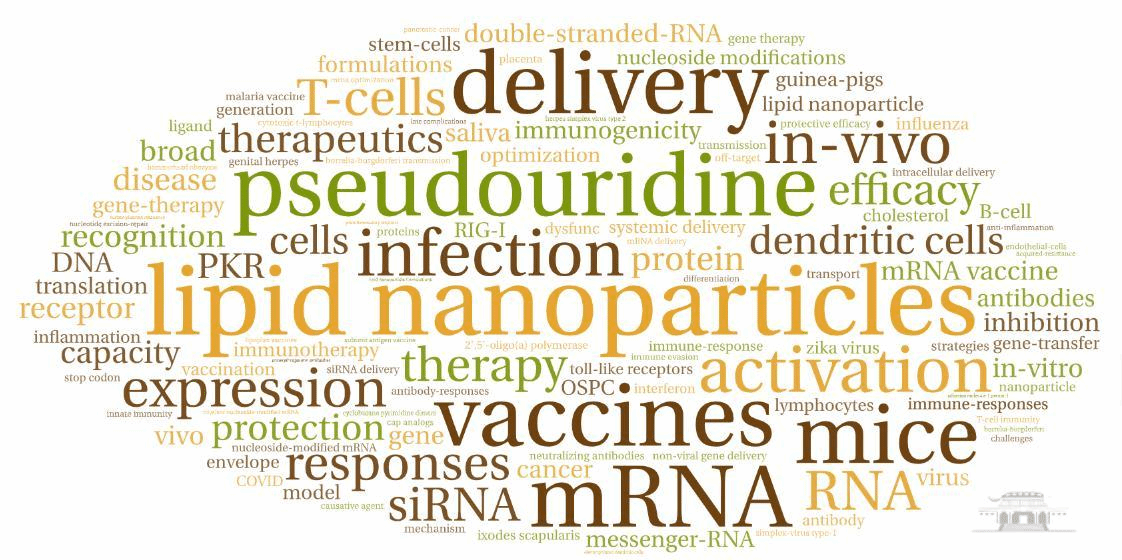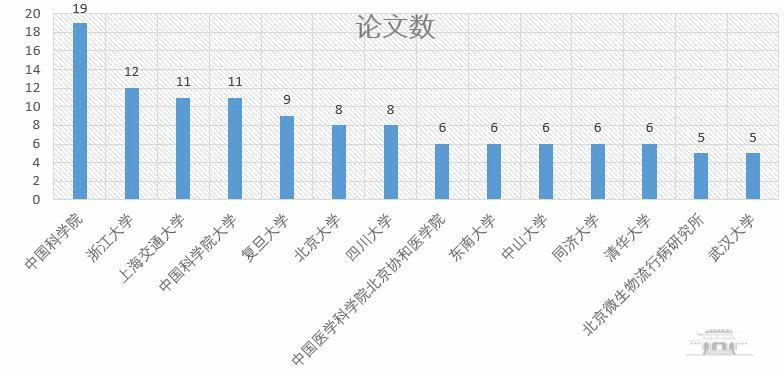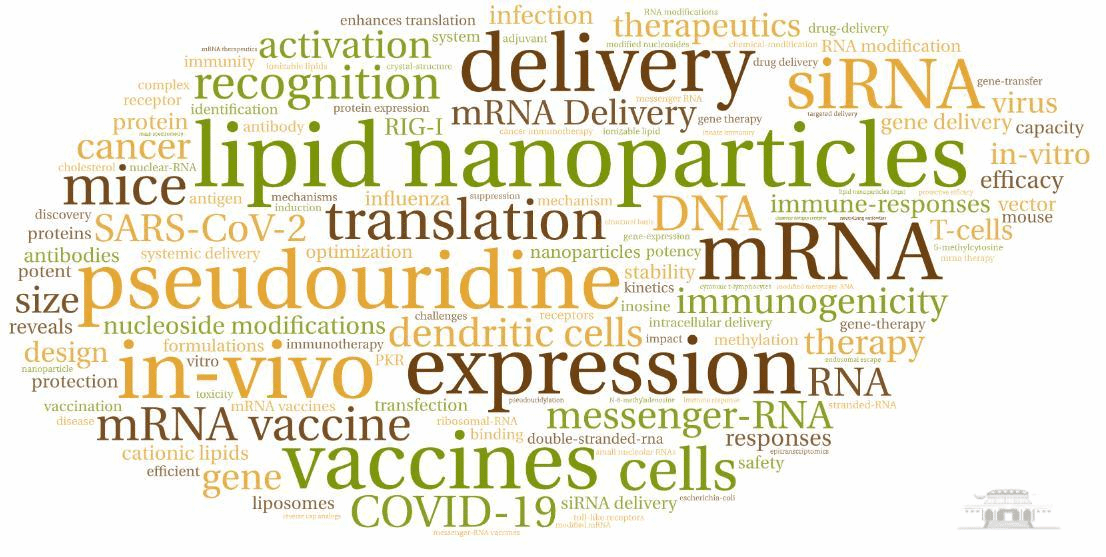信息整理:图书馆
2023年诺贝尔生理学或医学奖授予卡塔琳·考里科(Katalin Karikó)和德鲁·韦斯曼(Drew Weissman),以表彰他们在核苷碱基修饰方面的发现,这些发现使得针对COVID-19的有效的mRNA疫苗开发成为可能。以下对其相关主题学术论文和相关施引文献进行分析。
一、 获奖者的发文分析
Katalin Karikó和Drew Weissman发表WOS论文共计293篇,其中,诺奖相关主题论文111篇,发文的年度分布如图1所示。

图1 2023年诺贝尔生理学或医学奖获奖者WOS发文年度分布
相关主题论文111篇涉及免疫学、临床医学等学科领域,论文分布于54种期刊,其中,4篇发表在Nature上,3篇发表在Science上。
由于Incites数据库更新时间滞后,获奖者的293篇论文中有16篇论文不在分析之列;表1是其余277篇论文所涉及的10个ESI学科领域及各组论文的学科影响力表现。不难看出,获奖者在免疫学、药理学与毒理学、生物和生物化学、临床医学、微生物学等学科领域贡献突出,论文数占全部论文的76.45%,其中药理学与毒理学学科篇均被引高达217.26次。
表1 2023年诺贝尔生理学或医学奖获奖者论文归属学科及影响力表现
ESI学科 |
论文数 |
被引频次 |
篇均被引 |
学科规范化的引文影响力 |
平均百分位 |
排名前 1% 的论文 |
Immunology |
65 |
6491 |
99.86 |
4.79 |
57.05 |
11 |
Pharmacology & Toxicology |
19 |
4128 |
217.26 |
8.89 |
71.97 |
6 |
Biology & Biochemistry |
52 |
3137 |
60.37 |
2.88 |
62.6 |
5 |
Clinical Medicine |
71 |
2922 |
41.15 |
4.62 |
50.43 |
9 |
Microbiology |
17 |
1397 |
82.18 |
5.79 |
71.86 |
5 |
Molecular Biology & Genetics |
14 |
820 |
58.57 |
1.56 |
55.75 |
0 |
Neuroscience & Behavior |
12 |
447 |
37.25 |
0.52 |
31.95 |
0 |
Materials Science |
7 |
189 |
27 |
3.14 |
61.32 |
2 |
Multidisciplinary |
9 |
181 |
20.11 |
3.05 |
36.87 |
1 |
Chemistry |
11 |
149 |
13.55 |
3.45 |
54.54 |
1 |
由于Incites数据库更新时间滞后,111篇诺贝尔奖相关主题论文中仅有106篇论文可分析,共涉及9个ESI学科,各学科论文表现见表2。
表2 2023年诺贝尔生理学或医学奖相关主题论文归属学科及影响力表现
ESI学科 |
论文数 |
被引频次 |
篇均被引 |
学科规范化的引文影响力 |
平均百分位 |
排名前 1% 的论文 |
Immunology |
30 |
3940 |
131.33 |
7.16 |
56.96 |
7 |
Clinical Medicine |
29 |
1704 |
58.76 |
8.05 |
56.79 |
8 |
Biology & Biochemistry |
14 |
1301 |
92.93 |
5.63 |
84.31 |
3 |
Pharmacology & Toxicology |
11 |
1025 |
93.18 |
6.73 |
84.53 |
3 |
Microbiology |
10 |
952 |
95.2 |
5.82 |
73.29 |
3 |
Molecular Biology & Genetics |
4 |
204 |
51 |
2.13 |
69.03 |
0 |
Multidisciplinary |
1 |
146 |
146 |
5.79 |
97.53 |
0 |
Materials Science |
4 |
97 |
24.25 |
2.99 |
64.92 |
1 |
Chemistry |
3 |
38 |
12.67 |
7.79 |
85.9 |
1 |
通过对111篇相关主题文献的全部关键词进行词频统计,得到的高频关键词词云如图2,主要高频词有:lipid nanoparticles(32)、pseudouridine(16)、vaccines(14)、delivery(12)、mRNA(12)、expression(11)、infection(9)等。如图2所示。

图2 2023年诺贝尔生理学或医学奖相关主题文献的高频关键词词云
二、 相关施引文献分析
截至2023年11月1日,Katalin Karikó和Drew Weissman的111篇诺奖相关文献被全球5,668篇论文引用,总被引9,799次,篇均被引88.28次。从全球来看,施引文献逐年持续增长,2005年仅4篇、2020年高达1717篇。全部施引文献分布在112个国家/地区;排名第一的是美国,文献量达2,223篇;随后是中国(950篇)、德国(619篇)。
施引文献涉及的研究领域比较广泛;我们结合本次诺奖的获奖原因,从施引文献中筛选出与诺奖主题相关的论文共计783篇,下面从不同角度分析这些相关施引文献。
1. 发文年度分布
相关施引文献量呈逐年上升趋势,如图3所示,2005年1篇,2022年高达214篇。

图3 2023年诺贝尔生理学或医学奖相关施引文献年度分布
2. 发文期刊分布
783篇相关施引文献分布在293种期刊,发文较多的 20 种期刊刊登相关论文299篇、占全部相关主题论文的38.19%。TOP 20期刊见图4。

图4 2023年诺贝尔生理学或医学奖相关施引文献期刊分布(TOP 20)
3. 发文机构分布
783篇论文涉及全球56个国家/地区,其中,中国作者参与的相关施引文献共计138篇,论文数≥5篇的中国机构如图5所示。

图5 2023年诺贝尔生理学或医学奖相关施引文献中发文量≥5的中国机构
4. 引文主题领域分布
基于 Citation Topics的宏观领域,783篇相关主题论文涉及5个领域,主要集中在Clinical & Life Sciences(398篇,占50.83%)、Chemistry (342篇,占43.68%)两个领域。
中国作者参与的138篇论文涉及3个领域:主要集中在Clinical & Life Sciences(78篇,占56.52%)、Chemistry (47篇,占34.06%)两个领域。
基于 Citation Topics 的中观领域,783篇相关主题研究论文涉及70个中观领域,主要集中在Polymers & Macromolecules(164篇,占20.95%)、Nucleic Acids Chemistry(151篇,占19.28%)和Immunology(134篇,占17.11%)等领域。
中国作者参与的138篇论文涉及27个中观领域,主要集中在Immunology(35篇,占25.36%)、Nucleic Acids Chemistry(23篇,占16.67%)和Polymers & Macromolecules(23篇,占16.67%)等领域。
基于 Citation Topics 的微观领域,783篇相关研究论文涉及133个微观领域,主要集中在Gene Delivery(161篇,占20.56%)、Ribosome(104篇,占13.28%)、Dendritic Cells(86篇,占10.98%)等领域。
中国作者参与的138篇涉及40个微观领域,主要集中在Dendritic Cells(23篇,占16.67%)、Gene Delivery (23篇,占16.67%)和Ribosome (16篇,占11.59%)等领域。
上述数据表明,中国参与的相关论文与全球的相关论文从引文主题角度比较来看基本一致。
5. 高水平论文学科分布
相关施引文献中,近十年有高水平论文66篇,其中高被引论文65篇,热点论文7篇;66篇高水平论文中有中国作者参与的有6篇。表3是高水平论文中全球和中国作者参与的论文涉及的ESI学科及各组论文影响力表现比较。
表3 2023年诺贝尔生理学或医学奖相关主题施引文献中高水平论文归属学科及影响力表现
ESI学科 |
论文数 (全球/中国) |
被引频次 (全球/中国) |
篇均被引 (全球/中国) |
学科规范化的引文影响力 (全球/中国) |
Q1 期刊中的论文 (全球/中国) |
Clinical Medicine |
15/2 |
11973/274 |
798.2/137 |
76.33/12.38 |
14/2 |
Molecular Biology & Genetics |
10/3 |
2829/454 |
282.9/151.33 |
11.22/11.24 |
10/3 |
Immunology |
8/0 |
2242/0 |
280.25/0 |
22.83/0 |
6/0 |
Materials Science |
6/0 |
2083/0 |
347.17/0 |
11.61/0 |
6/0 |
Pharmacology & Toxicology |
11/1 |
1946/28 |
176.91/28 |
15.69/5.47 |
9/1 |
Biology & Biochemistry |
9/0 |
1267/0 |
140.78/0 |
11.73/0 |
9/0 |
Multidisciplinary |
2/0 |
1240/0 |
620/0 |
33.19/0 |
2/0 |
Microbiology |
2/0 |
675/0 |
337.5/0 |
20.02/0 |
2/0 |
Chemistry |
2/0 |
169/0 |
84.5/0 |
10.05/0 |
2/0 |
Plant & Animal Science |
1/0 |
101/0 |
101/0 |
8.13/0 |
1/0 |
6. 高频关键词
通过对783篇施引文献关键词进行词频统计、得到高频关键词词云,主要高频词有:lipid nanoparticles(230)、pseudouridine(177)、expression(109)、delivery(107)、vaccines(105)、in-vivo(103)、mRNA(93)等,如图6所示。对比获奖者相关文献词频分析,可发现二者的前7位高频词中有6个词是相同的;唯一不同的词是施引文献中的in-vivo和获奖者文献中的infection。

图6 2023年诺贝尔生理学或医学奖相关主题施引文献高频关键词词云
三、 相关主题高影响力论文
Katalin Karikó和Drew Weissman的111篇相关主题文献中有16篇高被引论文,3篇热点论文,合计16篇高水平论文,占比14.41%。111篇相关主题文献中被引次数最高的达1265次,发表于2005年。以下推荐ESI高水平论文及其它被引次数高的文献以供参考(按被引频次降序排列)。
1. Karikó K, Buckstein M, Ni H P, et al.Suppression of RNA recognition by Toll-like receptors: The impact of nucleoside modification and the evolutionary origin of RNA[J]. Immunity, 2005, 23(2): 165-175.
2. Sahin U, Muik A, Derhovanessian E, et al.COVID-19 vaccine BNT162b1 elicits human antibody and TH1 T cell responses[J]. Nature, 2020, 586(7830):594–599.
3. Karikó K, Muramatsu H, Welsh F A, et al.Incorporation ofPseudouridine Into mRNA Yields Superior Nonimmunogenic Vector With Increased Translational Capacity and Biological Stability[J]. Molecular Therapy, 2008, 16(11): 1833-1840.
4. Pardi N, Hogan M J, Pelc R S, et al.Zika virus protection by a single low-dose nucleoside-modified mRNA vaccination[J]. Nature, 2017, 543(7644): 248-251.
5. Pardi N, Tuyishime S, Muramatsu H, et al.Expression kinetics of nucleoside-modified mRNA delivered in lipid nanoparticles to mice by various routes[J]. Journal of Controlled Release, 2015, 217: 345-351.
6. Karikó K, Muramatsu H, Ludwig J, et al.Generating the optimal mRNA for therapy: HPLC purification eliminates immune activation and improves translation of nucleoside-modified, protein-encoding mRNA[J]. Nucleic Acids Research, 2011, 39(21) (2011-09-02) [2023-12-12].https://doi.org/10.1093/nar/gkr695.
7. Sahin U, Muik A, Vogler I, et al.BNT162b2 vaccine induces neutralizing antibodies and poly-specific T cells in humans[J]. Nature, 2021, 595(7868): 572-577.
8. Chaudhary N, Weissman D, Whitehead K A.mRNA vaccines for infectious diseases: principles, delivery and clinical translation[J]. Nature Reviews Drug Discovery, 2021, 20(11): 817-838.
9. Anderson B R, Muramatsu H, Nallagatla S R, et al.Incorporation of pseudouridine into mRNA enhances translation by diminishing PKR activation[J]. Nucleic Acids Research, 2010, 38(17): 5884-5892.
10. Pardi N, Hogan M J, Naradikian M S, et al.Nucleoside-modified mRNA vaccines induce potent T follicular helper and germinal center B cell responses[J]. Journal of Experimental Medicine, 2018, 215(6): 1571-1588.
11. Buschmann M D, Carrasco M J, Alishetty S, et al.Nanomaterial Delivery Systems for mRNA Vaccines[J]. Vaccines, 2021, 9(1).65; (2021-01-19) [2023-12-12] https://doi.org/10.3390/vaccines9010065.
12. Rurik J G, Tombácz I, Yadegari A, et al.CAR T cells produced in vivo to treat cardiac injury[J]. Science, 2022, 375(6576): 91-96.
13. Pardi N, Secreto A J, Shan X C, et al.Administration of nucleoside-modified mRNA encoding broadly neutralizing antibody protects humanized mice from HIV-1 challenge[J]. Nature Communications, 2017, 8. (2017-03-02) [2023-12-12]. https://www.nature.com/articles/ncomms14630.
14. Pardi N, Hogan M J, Weissman D.Recentadvances in mRNA vaccine technology[J]. Current Opinion in Immunology, 2020, 65: 14-20.
15. Karikó K, Muramatsu H, Keller J M, et al.Increased Erythropoiesis in Mice Injected With Submicrogram Quantities of Pseudouridine-containing mRNA Encoding Erythropoietin[J]. Molecular Therapy, 2012, 20(5): 948-953.
16. Laczkó D, Hogan M J, Toulmin S A, et al.A Single Immunization with Nucleoside-Modified mRNA Vaccines Elicits Strong Cellular and Humoral Immune Responses against SARS-CoV-2 in Mice[J]. Immunity, 2020, 53(4): 724-732.
17. Anderson B R, Muramatsu H, Jha B K, et al.Nucleoside modifications in RNA limit activation of 2'-5'-oligoadenylate synthetase and increase resistance to cleavage by RNase L[J]. Nucleic Acids Research, 2011, 39(21): 9329-9338.
18. Alameh M G, Tombácz I, Bettini E, et al.Lipid nanoparticles enhance the efficacy of mRNA and protein subunit vaccines by inducing robust T follicular helper cell and humoral responses[J]. Immunity, 2021, 54(12): 2877-2892.
19. Stadler C R, Bähr-Mahmud H, Celik L, et al.Elimination of large tumors in mice by mRNA-encoded bispecific antibodies[J]. Nature Medicine, 2017, 23(7): 815-817.
20. Pardi N, Parkhouse K, Kirkpatrick E, et al.Nucleoside-modified mRNA immunization elicits influenza virus hemagglutinin stalk-specific antibodies[J]. Nature Communications, 2018, 9. (2018-08-22) [2023-12-12].https://www.nature.com/articles/s41467-018-05482-0.
四、 高影响力施引文献
783篇相关主题施引文献中有高被引论文65篇,热点论文7篇(ESI 2023年9月更新数据),热点论文信息如下:
1. Hou X C, Zaks T, Langer R,et al.Lipid nanoparticles for mRNA delivery[J]. Nature Reviews Materials, 2021, 6(12): 1078-1094.
2. Thomas S J, Moreira E D, Kitchin N, et al.Safety and Efficacy of the BNT162b2 mRNA Covid-19 Vaccine through 6 Months[J]. New England Journal of Medicine, 2021, 385(19): 1761-1773.
3. Chaudhary N, Weissman D, Whitehead K A.mRNA vaccines for infectious diseases: principles, delivery and clinical translation[J]. Nature Reviews Drug Discovery, 2021, 20(11): 817-838.
4. Rurik J G, Tombácz I, Yadegari A, et al.CAR T cells produced in vivo to treat cardiac injury[J]. Science, 2022, 375(6576): 91-96.
5. Albertsen C H, Kulkarni J A, Witzigmann D, et al.The role of lipid components in lipid nanoparticles for vaccines and gene therapy[J]. Advanced Drug Delivery Reviews, 2022, 188. (2022-09) [2023-12-12].https://doi.org/10.1016/j.addr.2022.114416.
6. Huang X G, Kong N, Zhang X C, et al.The landscape of mRNA nanomedicine[J]. Nature Medicine, 2022, 28(11): 2273-2287.
7. Arevalo C P, Bolton M J, Le Sage V, et al.A multivalent nucleoside-modified mRNA vaccine against all known influenza virus subtypes[J]. Science, 2022, 378(6622): 899-904.
(编辑:张惠荣 审核:汪雁、刘颖)
